Spring, 1980: Revisited
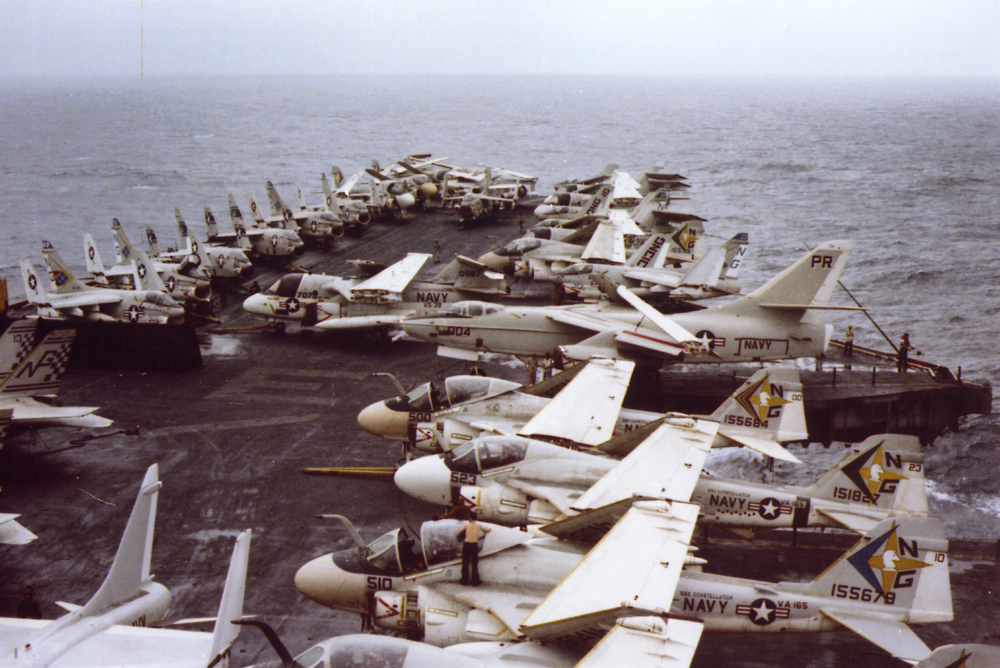
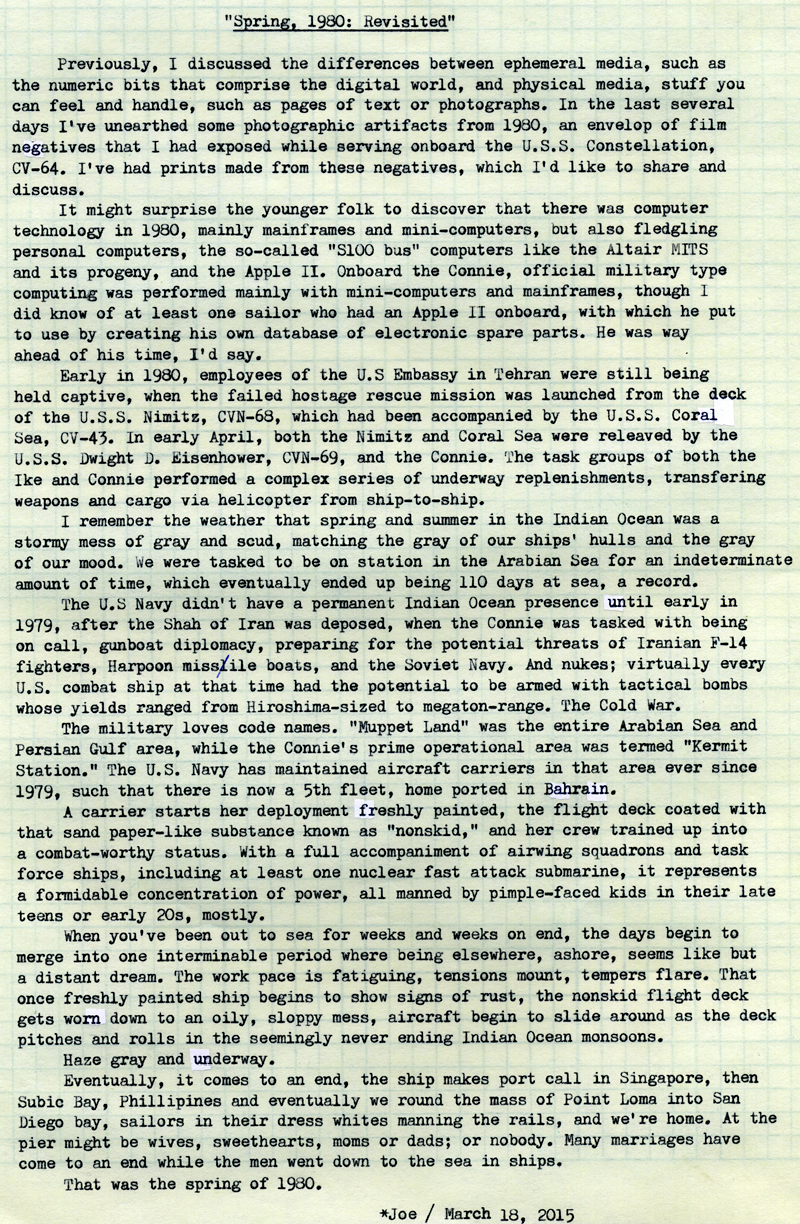
Post-Script: In 1980, the two most common music formats were LPs (i.e. vinyl) and cassette tape. Just before leaving port in Subic Bay for the Indian Ocean, in early April, one of our crew members purchased the just-released album of Pink Floyd's "The Wall." That music was what helped us to survive the ordeal of an interminable duration at-sea. To this day, I cannot listen to that album without thinking back to those days.
Photos via Minolta SRT-101b and Vivitar 80-200mm lens on Kodacolor film. Keep in mind that in 1980, though there were computers available, photography was strictly via film. Though these negatives have faded color, through years of being poorly archived, the images are clearly evident. Typecast via Hermes Rocket.
Bonus Images:
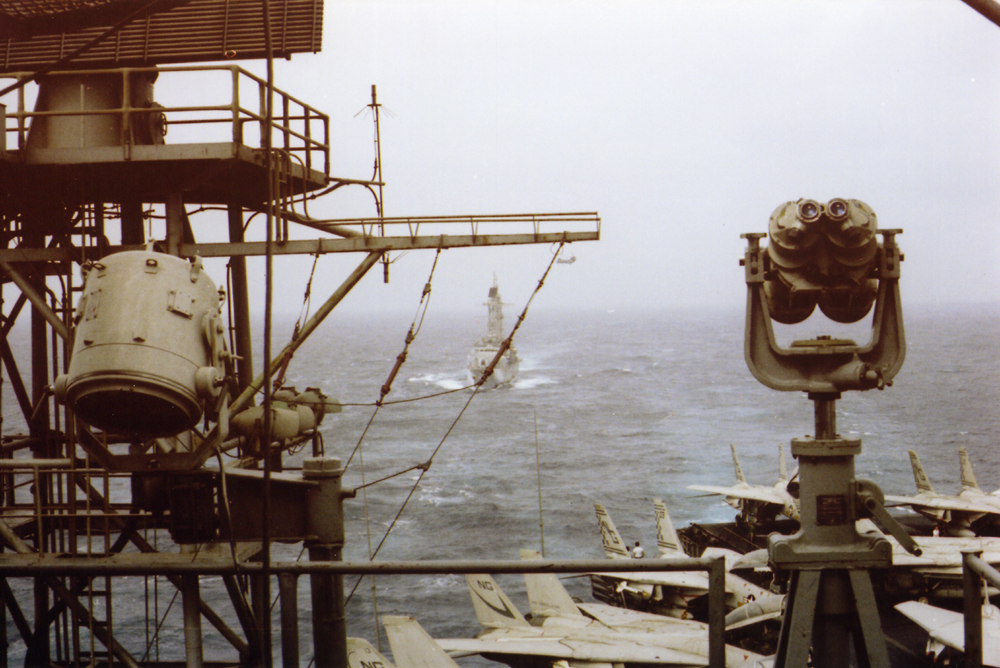 Looking aft from atop the superstructure (i.e. the "Island"). Wouldn't you like to have one of those shipboard binoculars? In the bottom of the image are the F14s staged along the fantail; in the distance, aft of the Connie, is one of our escort ships.
Looking aft from atop the superstructure (i.e. the "Island"). Wouldn't you like to have one of those shipboard binoculars? In the bottom of the image are the F14s staged along the fantail; in the distance, aft of the Connie, is one of our escort ships.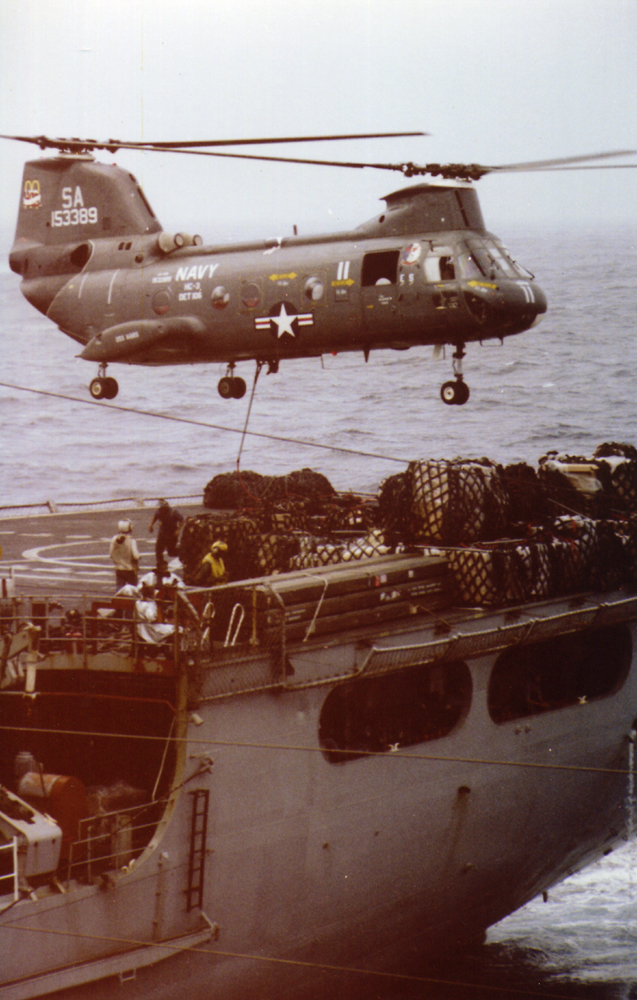 Underway replenishment. A helo is beginning to lift a load of cargo. Prior to hooking the line from the cargo to the helo, a crewmember touches the chopper with a grounding rod, discharging the high voltage built up during flight, that's lethal enough to kill a man. These smaller ships can pitch, heave and roll while the helo hovers above, implying that the pilot has to be skilled enough to match the ship's motion, in order to hover above the deck. I was always amazed to watch the helos operate, impressed by their pilot's skill. Fighter pilots might get all the notoriety, but a navy runs on supply lines, and helos are its workhorse.
Underway replenishment. A helo is beginning to lift a load of cargo. Prior to hooking the line from the cargo to the helo, a crewmember touches the chopper with a grounding rod, discharging the high voltage built up during flight, that's lethal enough to kill a man. These smaller ships can pitch, heave and roll while the helo hovers above, implying that the pilot has to be skilled enough to match the ship's motion, in order to hover above the deck. I was always amazed to watch the helos operate, impressed by their pilot's skill. Fighter pilots might get all the notoriety, but a navy runs on supply lines, and helos are its workhorse.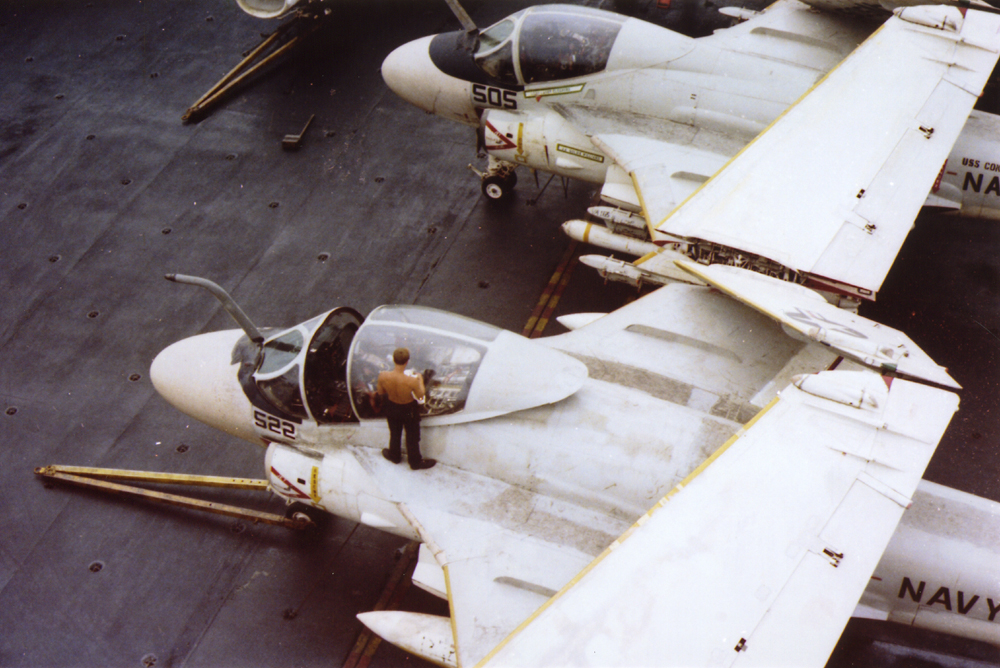 A6s being serviced by their ground crew. The A6 was a great carrier-based bomber, could carry its own weight in ordinance. The A6 near the top of the image has live ordinance attached to its left wing. The yellow tow bars are used to maneuver the craft along the deck, via "yellow-gear" diesel-powered tractors, fueled by JP-4 jet fuel. The "brown shirt" crewmember is known as the "plane captain;" he's the enlisted man chiefly in charge of ensuring that plane is prepared for launch.
A6s being serviced by their ground crew. The A6 was a great carrier-based bomber, could carry its own weight in ordinance. The A6 near the top of the image has live ordinance attached to its left wing. The yellow tow bars are used to maneuver the craft along the deck, via "yellow-gear" diesel-powered tractors, fueled by JP-4 jet fuel. The "brown shirt" crewmember is known as the "plane captain;" he's the enlisted man chiefly in charge of ensuring that plane is prepared for launch.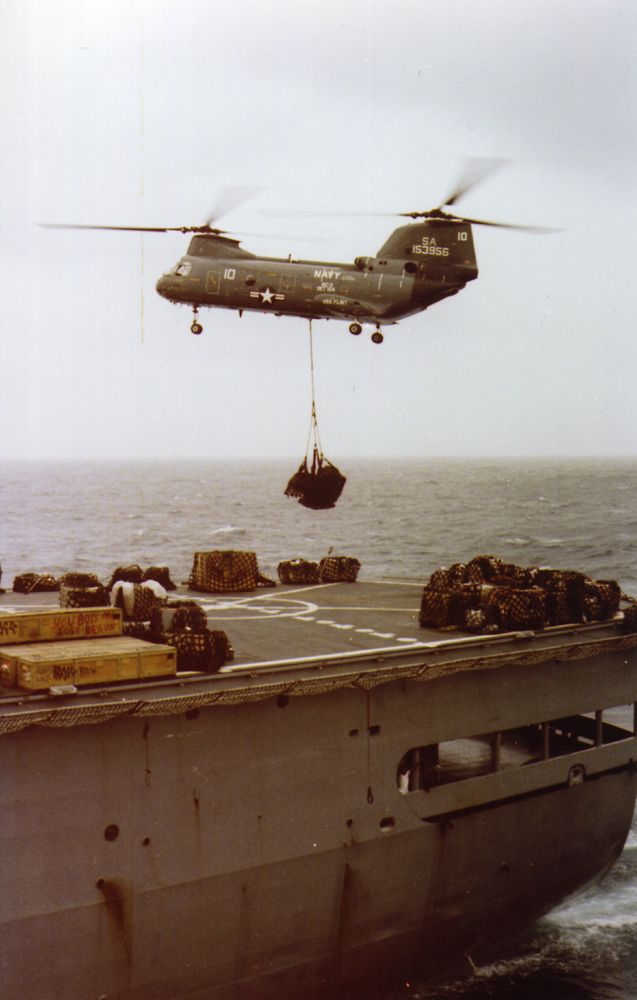 More cargo being transferred. The long wooden crates might be missiles of some kind (perhaps Terrier missiles; the Connie was the last carrier in the Navy to have nuclear warhead-certified Terrier missiles). Note the graffiti on one such crate, "you boys just begun."
More cargo being transferred. The long wooden crates might be missiles of some kind (perhaps Terrier missiles; the Connie was the last carrier in the Navy to have nuclear warhead-certified Terrier missiles). Note the graffiti on one such crate, "you boys just begun."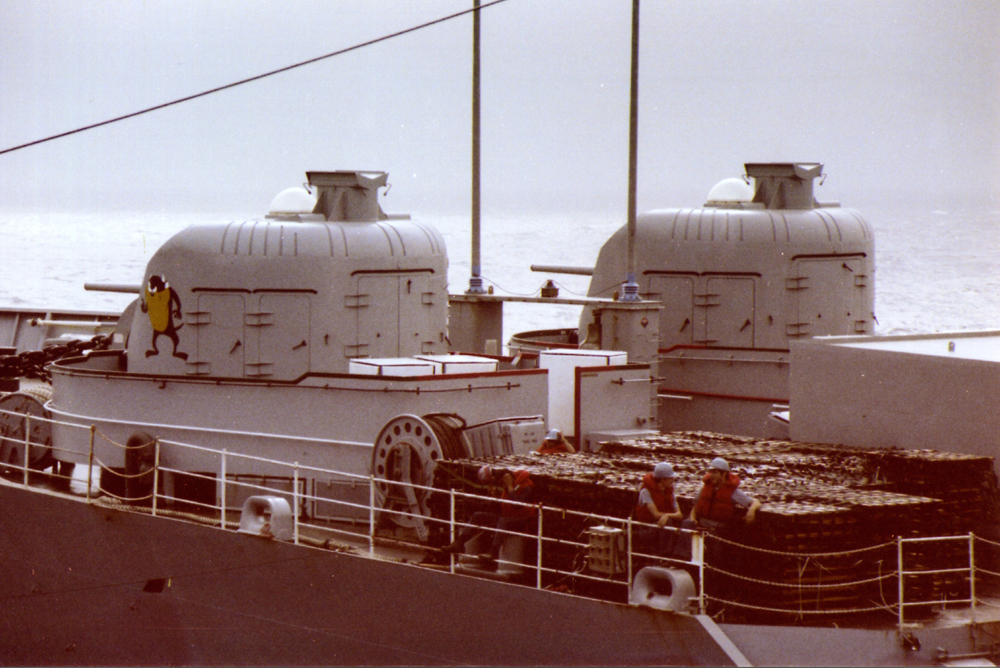 Alongside a supply ship. Note the 5" gun mounts, and the "Taz" artwork.
Alongside a supply ship. Note the 5" gun mounts, and the "Taz" artwork. An F14 Tomcat, from fighter squadron VF-211, on glide slope, calling the ball. He'll most likely trap on the number 3 arresting wire (there being four such wires). Each wire is a 1" braided steel cable, that runs underneath the deck to special hydraulic machinery that plays out the cable at a controlled rate, depending on aircraft type and weight. My sleeping quarters was a top bunk on the "03 level," just below the flight deck, and just underneath the number 3 wire. Flight operations happened upwards of 18 hours per day; attempting to sleep while flight ops was underway involved a 90 second cycle of sleep, then awakening to the whine/slam/screech of an aircraft being arrested on your roof, just above your head.
An F14 Tomcat, from fighter squadron VF-211, on glide slope, calling the ball. He'll most likely trap on the number 3 arresting wire (there being four such wires). Each wire is a 1" braided steel cable, that runs underneath the deck to special hydraulic machinery that plays out the cable at a controlled rate, depending on aircraft type and weight. My sleeping quarters was a top bunk on the "03 level," just below the flight deck, and just underneath the number 3 wire. Flight operations happened upwards of 18 hours per day; attempting to sleep while flight ops was underway involved a 90 second cycle of sleep, then awakening to the whine/slam/screech of an aircraft being arrested on your roof, just above your head. Transfering cargo from the Ike, via helo. Note the dark green metal canisters on the fantail of the supply ship, those are probably spare jet engines. Haze gray and underway.
Transfering cargo from the Ike, via helo. Note the dark green metal canisters on the fantail of the supply ship, those are probably spare jet engines. Haze gray and underway.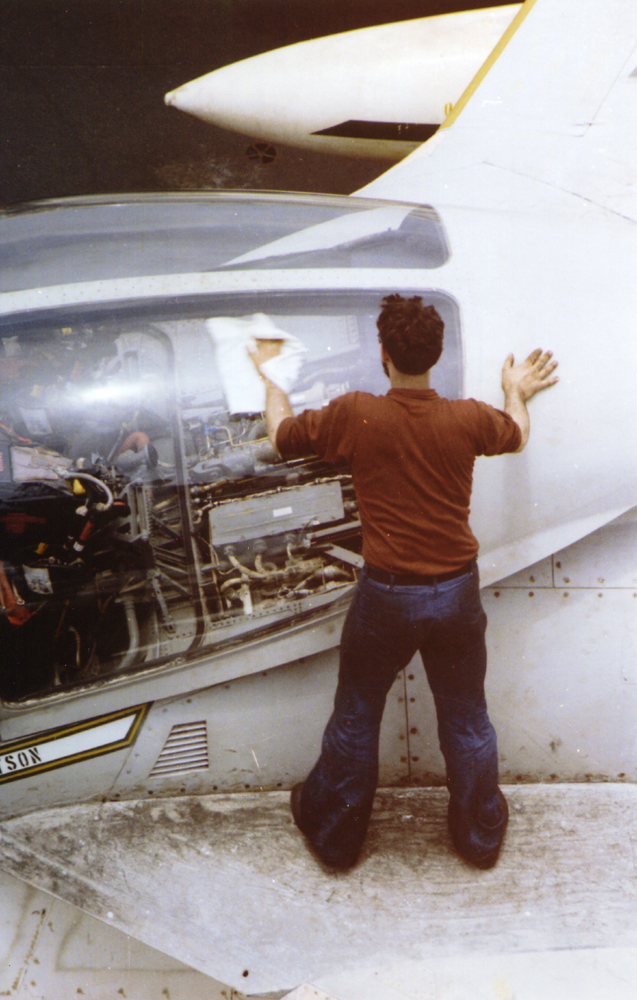 Bell-bottom dungarees. One's hair was permitted to get just a bit shaggy while on extended deployment. Note also this plane captain is sporting a short beard. I, too, grew a beard while in the Navy, which I've had ever since. Note how dirty & greasy these planes can get while out at sea. Not to mention the corrosion from salt spray. Something the air force doesn't have to deal with.
Bell-bottom dungarees. One's hair was permitted to get just a bit shaggy while on extended deployment. Note also this plane captain is sporting a short beard. I, too, grew a beard while in the Navy, which I've had ever since. Note how dirty & greasy these planes can get while out at sea. Not to mention the corrosion from salt spray. Something the air force doesn't have to deal with.

1 Comments:
Thank you for the interesting glimpse.
How can it be that 1980 was 35 years ago? I remember it well. But it was, in many ways, a different world ...
Post a Comment
<< Home